 This is a Sokol Automat, a 35mm rangefinder camera produced by LOMO (Leningradskoe Optiko Mechanichesckoe Objedinenie) in the Soviet city of Leningrad between the years 1966 and 1978. The Sokol is a large and heavy camera capable of full programmed automatic exposure via three CdS cells (earlier examples had six) above the taking lens. The design and operation of the Sokol was heavily influenced by Japanese rangefinders of the day, including the use of a Copal licensed leaf shutter behind the Industar-70 lens. With additional features like automatic parallax correction, and automatic resetting exposure counter, and a simplified film loading sequence, the Sokol was one of the more advanced Soviet rangefinders ever made.
This is a Sokol Automat, a 35mm rangefinder camera produced by LOMO (Leningradskoe Optiko Mechanichesckoe Objedinenie) in the Soviet city of Leningrad between the years 1966 and 1978. The Sokol is a large and heavy camera capable of full programmed automatic exposure via three CdS cells (earlier examples had six) above the taking lens. The design and operation of the Sokol was heavily influenced by Japanese rangefinders of the day, including the use of a Copal licensed leaf shutter behind the Industar-70 lens. With additional features like automatic parallax correction, and automatic resetting exposure counter, and a simplified film loading sequence, the Sokol was one of the more advanced Soviet rangefinders ever made.
Film Type: 135 (35mm)
Lens: 50mm f/2.8 Industar-70 (ИНДУСТАР-70) coated 4-elements in 3-groups
Focus: 0.8 meters to Infinity
Viewfinder: Coincident Image Coupled Rangefinder with Automatic Parallax Correction
Shutter: Copal Licensed Leaf Shutter
Speeds: B, 1/30 – 1/500 seconds
Exposure Meter: Coupled CdS Cell w/ Viewfinder Display and Programmed AE
Battery: 1.35v PX625 Mercury Battery
Flash Mount: Cold shoe and M and X Flash Sync
Weight: 786 grams
Manual (similar model #1, in Russian): http://www.rangefinder.ru/manual/instructions/cameras/sokol2_v.1.pdf
Manual (similar model #2, in Russian): http://www.rangefinder.ru/manual/instructions/cameras/sokol2_v.2.pdf
How these ratings work |
The LOMO Sokol Automat is an attractive looking camera that has an unusually Japanese style for a Soviet camera. Built with familiar ergonomics, fully programmed auto exposure, a good viewfinder and lens, and a style unlike that of any other Soviet cameras, the Sokol Automat is a camera worth considering in your collection. They’re not super common, especially out west, but if you can find one in good working condition, it is one that likely will not disappoint. | ||||||
| Images | Handling | Features | Viewfinder | Feel & Beauty | History | Age | |
| 1 | 1 | 1 | 2 | 2 | 1 | 20% | |
| Bonus | none | ||||||
| Final Score | 9.6 | ||||||
History
During the three-quarters of a century the Soviet Union existed, a great number of cameras and other photographic products were produced by a large number of Soviet factories. Unlike cameras produced in capitalist countries in which a corporation builds a product for sale to consumers, the manufacture of cameras was controlled by the government. Employees at a factory were told what to build and how many.
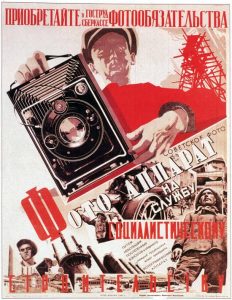
Several factories where cameras and other optical equipment originally built other things, and the earliest factory actually predates the Soviet Union itself. Formed in 1914 in the city of Petrograd (now St. Petersburg) the Russian Joint-Stock Company of Optical and Mechanical Production opened, building early optics products such as rifle scopes during the first World War. Over the next 20 years, this factory would change names several times and experience many changes in leadership. In 1924, Petrograd would be renamed Leningrad, and the factory would go through a series of name changes, from GOZ, TOMP, VTOMP, VOOMP, and in 1932 to Gosularstvennyi Optiko-Mekhanicheskii Zavod, or GOMZ for short.
In 1962, the factory would once again change it’s name first to LOOMP (Leningrad Optical and Mechanical Association of Enterprises), and then in 1964 to LOMO (Leningrad Optical-Mechanical Union), the name it still uses today.
In it’s earliest years, GOMZ produced various folding sheet and roll film cameras based heavily off German designs. One of it’s most successful early designs was a 9×12 folding bed camera called the Fotokor-1 which was produced from 1930 through 1941. During the 1930s, GOMZ was the Soviet Union’s primary maker of medium format cameras, but they also dabbled in 35mm design.

Many people think that the Soviet FED rangefinder produced in Kharkov, Ukraine was the first Soviet Leica inspired 35mm rangefinder, but it was actually the Leica II inspired Pioneer made between 1933 and 1937. Less than 1200 VOOMP Pioneers were produced before production ended. By this time, the FED Labour Commune was already up and running churning out large numbers of FED rangefinders.
By 1937, the FED factory took over exclusive production of Soviet Leica copies, leaving GOMZ and other Soviet factories to concentrate on other products. The FED factory’s location in Kharkov meant that it was vulnerable to invading German forces during the war, so in 1941 production stopped and what could be easily moved would be transported farther inland towards Moscow where it could be better protected.
With the shut down of the FED factory, the GOMZ factory in Leningrad, Russia and nearby KMZ in Moscow would be the first Soviet optics factories to resume camera production after the war.
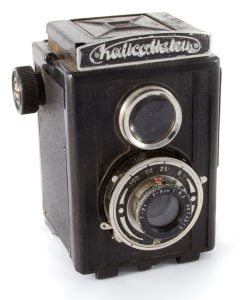
GOMZ benefited from the Soviet Union’s occupation of East Germany after the war where various German optics factories were dismantled and shipped to various locations within the Soviet Union. As a result, in 1946 GOMZ was able to quickly start production on a new camera called the Komsomolets which was very similar to the Voigtländer Brillant “pseudo-TLR”. The Komsomolets was the first all new camera to start production in the Soviet Union after the war. It would receive various revisions throughout it’s life including a name change in 1949 to the Lubitel.
The Lubitel was an extremely popular camera in both the Soviet Union and export countries as it was lightweight, small, cheap, easy to use, and produced better than average photographs. The original model would remain in production until about 1988, and in 2008 would be re-released by a new company as the Lubitel Universal 166+ which is still in production to this very day.
With the success of the Lubitel, the GOMZ factory was able to expand, releasing several new, and increasingly competitive designs. It’s first post war 35mm camera was the Smena which started production in 1953. A simple and compact 35mm scale focus camera with an entirely Bakelite body, the Smena would launch an entire family of compact point and shoot 35mm compact cameras that would exist up until after the fall of the Soviet Union in the 1990s.
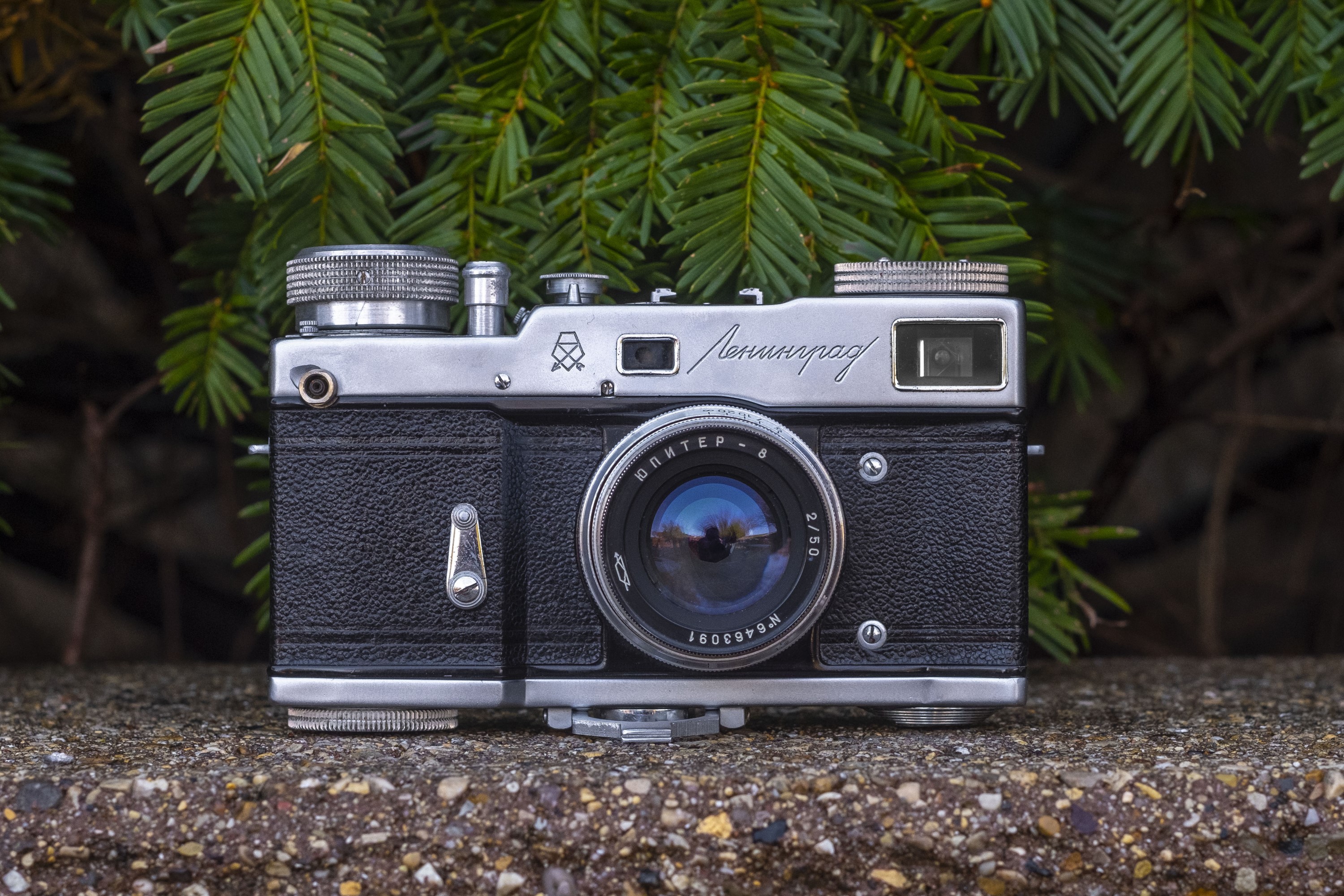
Of the two more ambitious cameras produced by GOMZ, one was the Leningrad, a 35mm rangefinder camera that used the M39 Leica Thread Mount, but otherwise was a completely unique camera. Built like a tank, and using a wind up clockwork film advance, and a unique prism based beamsplitter, the Leningrad was one of the highest end cameras made in the Soviet Union at the time.
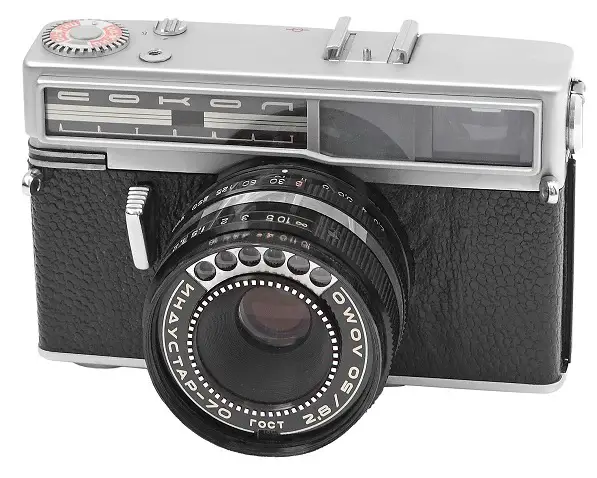
The other, was a camera that would eventually be called the Сокол Автомат or Sokol Automat, which translated to English means Falcon. Like the Leningrad which was different from any other Soviet camera, the Sokol Automat took great inspiration from the increasing number of Japanese rangefinder cameras of the era. Featuring a large body with squared off edges, the camera was not unlike that of the Minolta Hi-Matic, Olympus 35, or Yashica Electro.
Also, like those cameras, the Sokol Automat’s central leaf shutter was based on the Copal leaf shutter, produced by Copal Company LTD in Tokyo, Japan. While you might assume that the engineers simply took apart a Japanese camera and copied the Copal shutter, there is evidence that the shutter technology was licensed by Copal.

Quite a number of sites online suggest that the Sokol Automat used a Copal shutter without offering any further specifics, but this Japanese language website takes it a step farther and compares the inner workings of the Sokol Automat’s shutter, comparing that of the shutter in a Fujica Auto M, and declaring that the two shutters use the same technology. A short clipping from another Japanese site which no longer exists, suggests that in 1963 a Soviet delegation visited Copal and licensed the shutter for an unnamed Zenit SLR, possibly the Zenit 4-6 series. It does not specifically say that the Sokol Automat uses a Copal shutter, but there’s enough evidence to strongly suggest it is possible.
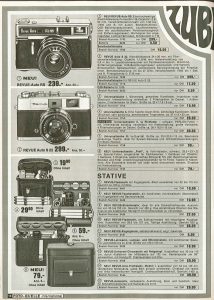
The Sokol Automat would make it’s debut in 1966, the same year as the Yashica Electro and would have a domestic price of 145 roubles, which is priced just below that of a Kiev 4, but above a Zorki 4.
Converting historical Soviet currency to modern day US dollars is nearly impossible to do, so a better method for determining the value of the Sokol Automat was to compare the price of an export Revue Auto RS with that of another known camera. In the ad to the left from the Nuremberg, Germany retailer, Foto-Quelle, the Revue appears right above the Revue Auto S 22 which is clearly a rebadged Konica Auto S2. In the US, the 1966 retail price of the Konica Auto S2 was $110.
In the Foto-Quelle ad, the Konica sells for exactly 20% higher than the Sokol Automat, suggesting that if the Soviet camera was sold alongside a Konica Auto S2, it might have cost 20% less and be priced around $88. This is a huge leap of course, as without any real world US ads for the camera, guessing what a retailer might have priced it at is pretty difficult to do.
As was the case of many of the Soviet Union’s better cameras, the Sokol Automat was heavily exported to other countries, including the United States. As a result, a huge number of variations of the camera exist, some spelling out SOKOL in Roman letters, and others with completely unique names. Examples such as the Revue Auto RS and Aurora Automat were made, but are very rare.
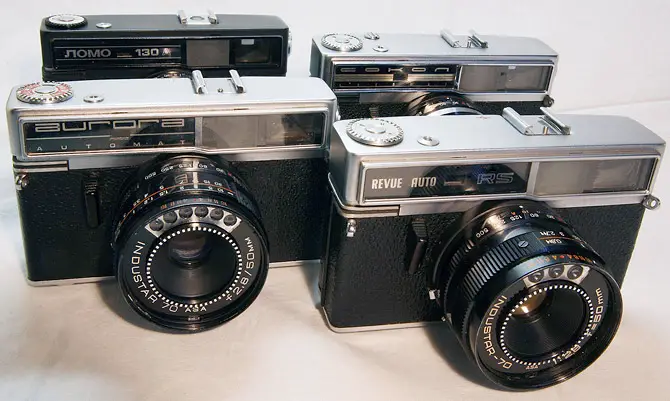
Throughout the twelve years the camera was produced, several changes to the camera were made, the most obvious of which happened in 1969 when the original six meter cells above the lens was reduced to three. Other changes include, relocating the battery check switch from the top to the back plate, the shutter release switching from metal to plastic, relocating the MX flash sync ports to the body, changes to the body covering, and a bunch of different designs for the logo plate.

In 1973, a budget version of the Sokol Automat was produced called the LOMO 130A. The camera wasn’t much different, sharing the same body and lens but reduced the meter cells from three to one. Despite being a “budget” camera, it added a flash hot shoe, something not available on the original Sokol Automat, and almost always came in black, which for western photographers was often a sign of a more professional camera. The LOMO 130A was a short lived model and was produced in very small numbers, with around 1000 thought to have been made.
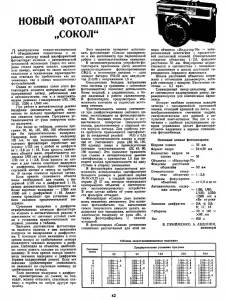
The last major change to the Sokol Automat came in 1977 with the release of the Sokol 2. Despite the name, the Sokol 2 is still very similar to the original model, but added the flash hot shoe from the LOMO 130A and revised the film take up spool to make it easier to load. As with the Sokol Automat, the camera was also available for export with several name variations produced.
The Sokol 2 was produced until 1987, making it one of the longer lived of all Soviet cameras. Production numbers of the first model are right around 300,000 units with an unknown number of the Sokol 2 made. If the habits of the Soviet camera industry were maintained throughout the 10 year production run of the second model, it stands to reason that close to that same number were also made.
Today, finding examples of the Sokol Automat and the later Sokol 2 is not hard, as many are for sale on eBay and other online marketplaces. It being a bit more complicated of a camera than the millions of FED and Zorki rangefinders and Zenit SLRs, finding one in working condition is a bit more of a challenge, however. That’s not to say the Sokol Automat was a poorly built camera, in fact, I’d say it’s probably on par with many other 1960s German and Japanese electronic rangefinders. Some work, but many don’t.
For the collector, the Sokol series is desirable, not only for it’s looks, but that such a huge number of variations of the camera exist. If you can find some of the rarer Aurora or Revue Models, they can fetch quite a high dollar, but even nice looking Sokol branded cameras can still top the $100 in working condition, and if they work, are excellent to shoot.
Repairs
Although I didn’t need to do any repairs to the shutter on the Sokol, I did find somewhat of a repair manual for the Sokol. It’s entirely in Russian, but there are enough images to where it would likely be helpful for someone wanting to tear down their own camera at the following link:
http://www.rangefinder.ru/manual/catalogs/sokol_catalog.pdf
My Thoughts
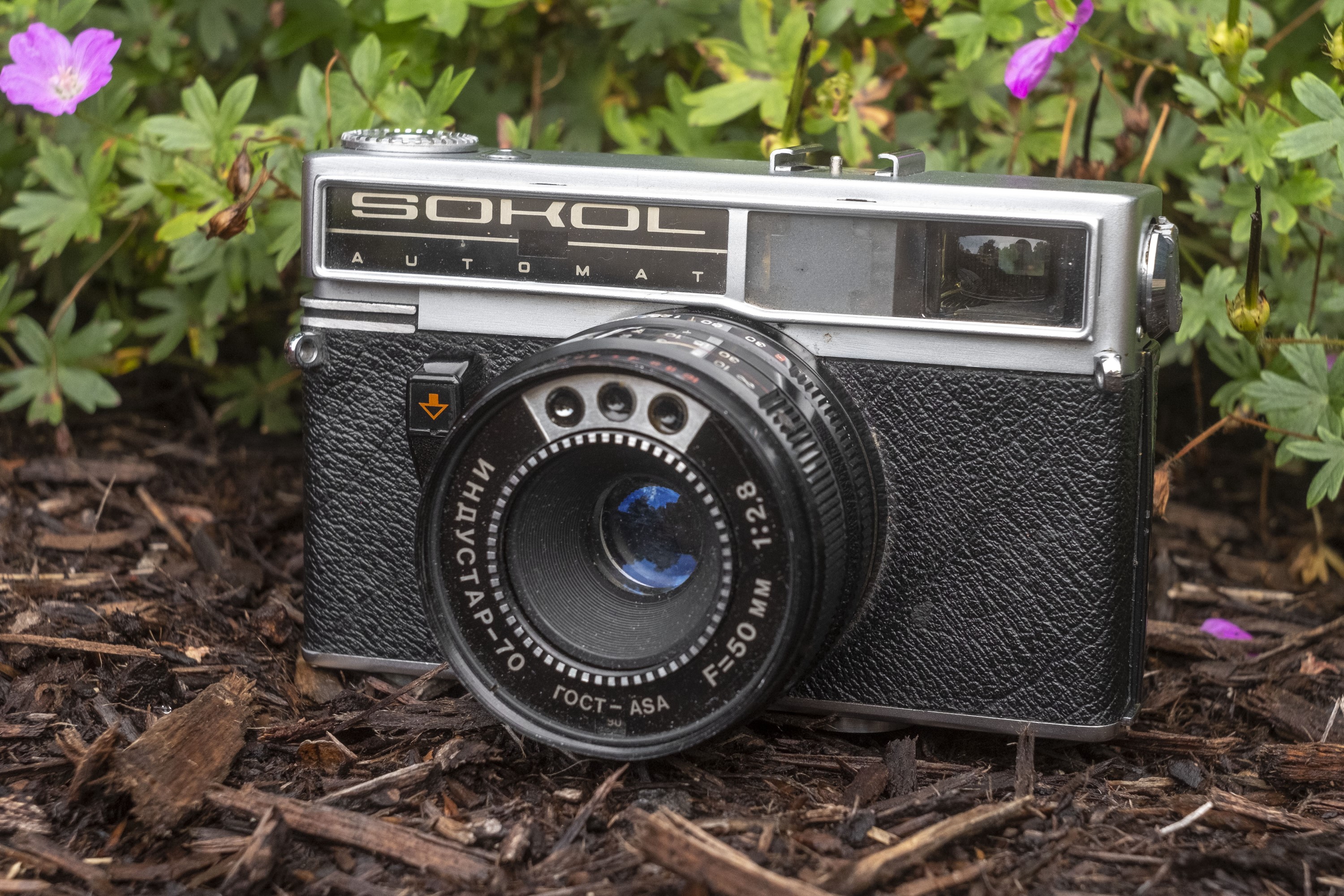
While I don’t agree with the statement that Soviet cameras are inferior to those built in other countries, I understand why many people think that way.
Much like how for most of the second half of the 20th century, American cameras were dismissed as cheap pieces of plastic and not to be taken seriously by “real” photographers, a majority of people’s experiences with Soviet cameras were with one of the millions of Leica copies or inexpensive Smena and Zenit cameras produced.
But like most things, once you scratch beneath the surface of all the Zorkis, there are some very interesting models which I’ve previously covered on this site.
The first time I saw a Sokol Automat, I thought, “Wow! That doesn’t look at all like a Soviet camera!” And in some ways, it’s not. The Sokol Automat is very much like Japanese rangefinders of the era with automatic exposure, automatic parallax correction, automatic resetting exposure counter, and a (supposedly) Japanese licensed shutter.
Cover up all the writing on the name plate and lens, and the overall shape of the camera could easily be mistaken for that of a Yashica, Konica, or Olympus of the same era with it’s large rectangle shape and sharp corners.
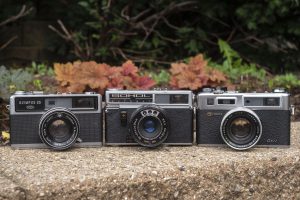
Compared to a Yashica Electro and Konica Auto S2 at 719 grams and 749 grams respectively, the Sokol Automat is a bit heavier at 786 grams and within 1-2 mm in every dimension. The back of the camera bows out a little more in the middle than other Japanese cameras which according to Alfred Klomp’s review of the camera says is a result of the very large back focus needed by the Indusar-70 lens. Klomp seems to suggest that this lens was not ideal for this camera due to it’s size, but truth be told, looking at the Sokol compared to the other Japanese rangefinders, there’s nothing about the Sokol Automat that makes it feel or look significantly larger than these other cameras.
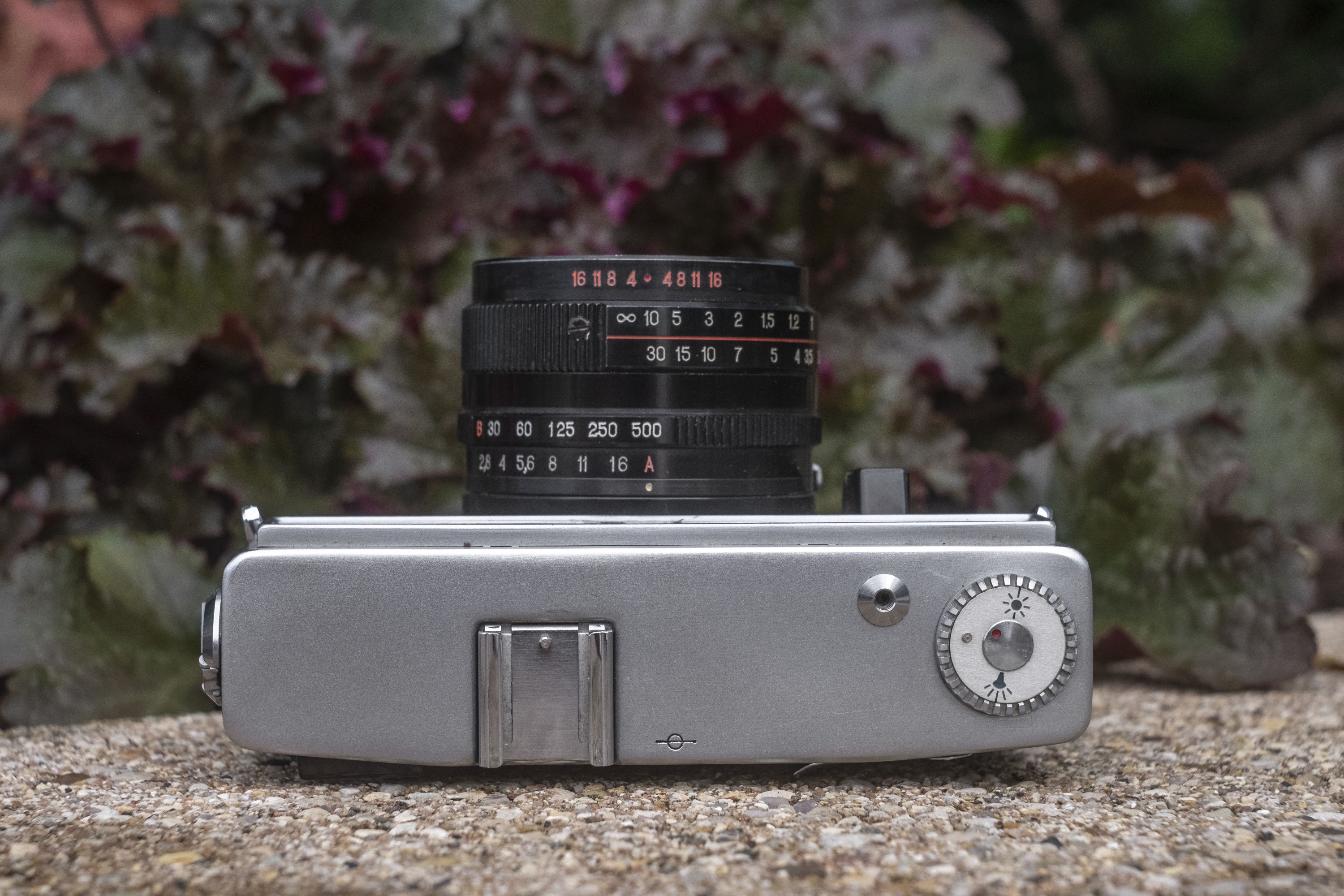
If there’s one area the Sokol Automat doesn’t look Japanese, it’s the top plate which apart from the accessory shoe, a threaded cable release socket, and film reminder dial, is completely empty. Beneath the film reminder dial is the battery compartment for the PX625 battery which is required to operate the camera in auto exposure mode.
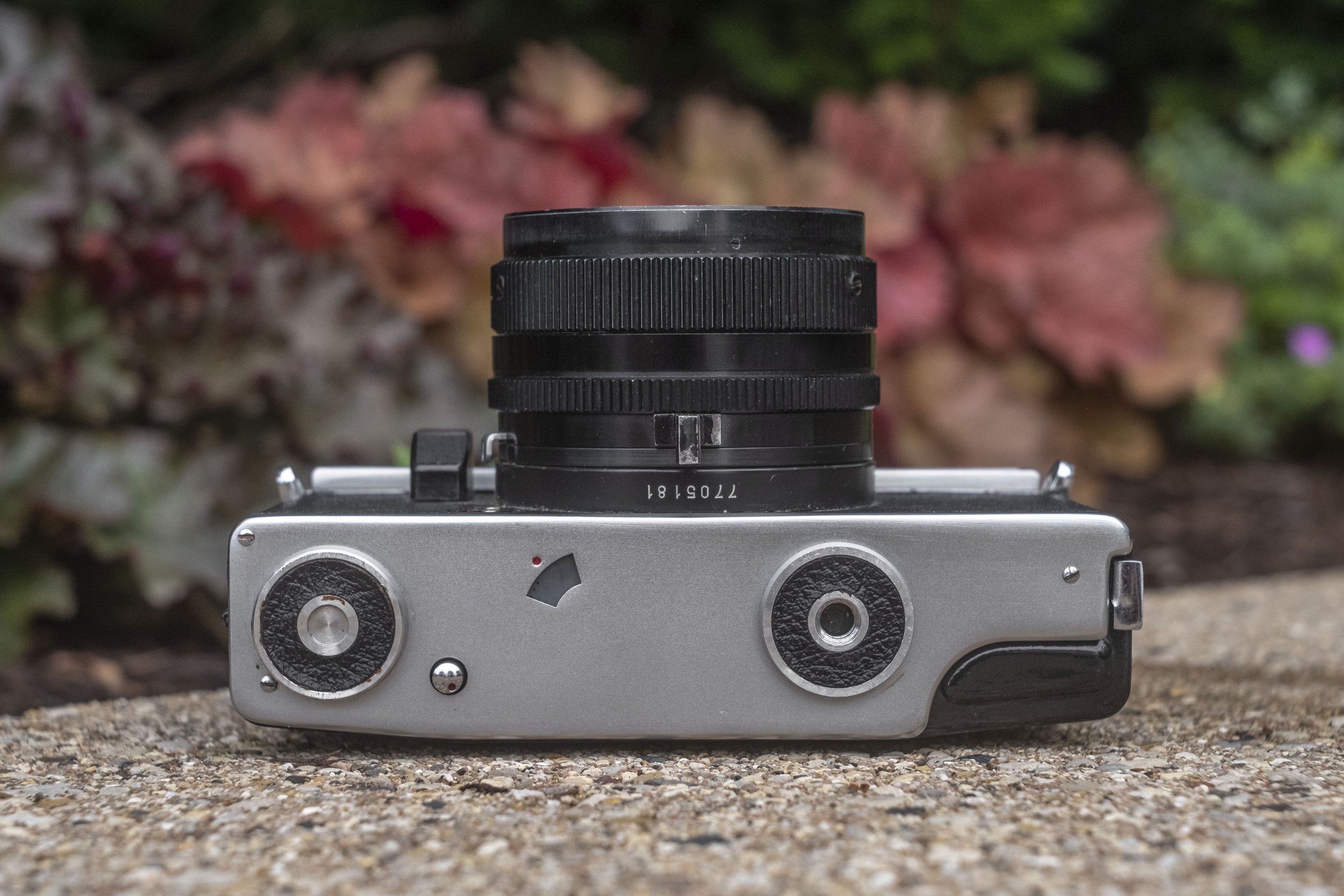
Like most cameras with barren top plates, flip the camera over and you’ll find a few more things.
An offset 1/4″ tripod socket sits on a foot, which is offset by a second foot on the opposite side of the camera to give it balance when sitting on a flat surface. The weight and size of the lens and shutter make the camera front heavy, so it naturally wants to lean forward on any flat surface. Between the two feet is the automatic resetting exposure counter and rewind release button.
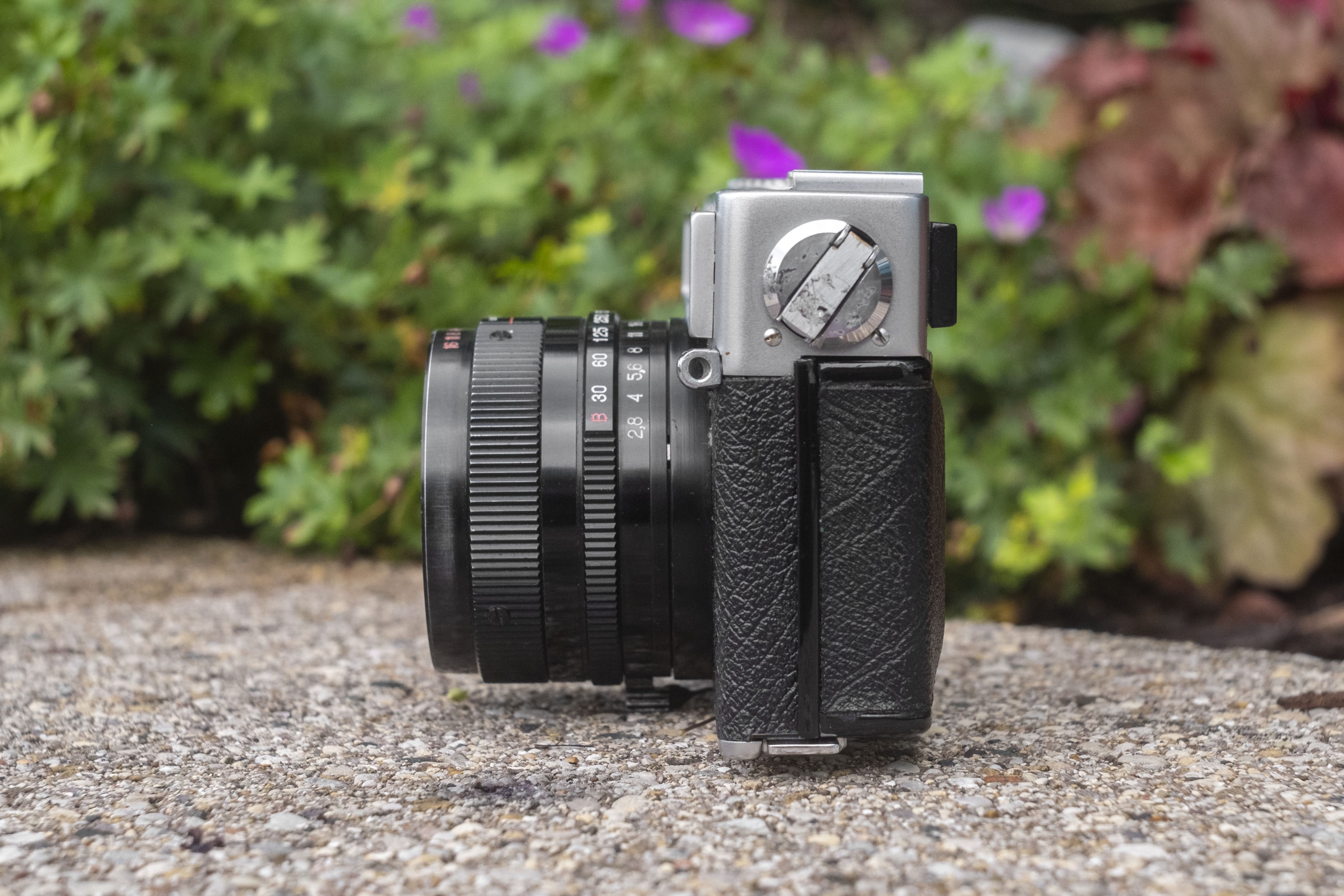
Speaking of rewinding the camera, if you’re wondering where the rewind knob is, it is located on the camera’s right side, similar to many Fuji cameras of the era like the Fujica 35-ML. Having the rewind knob on the side would normally allow for the width of the camera to be shortened, but that doesn’t appear to be the motivation with the Sokol Automat. Also on this side, near the bottom, is the release catch for the film door.
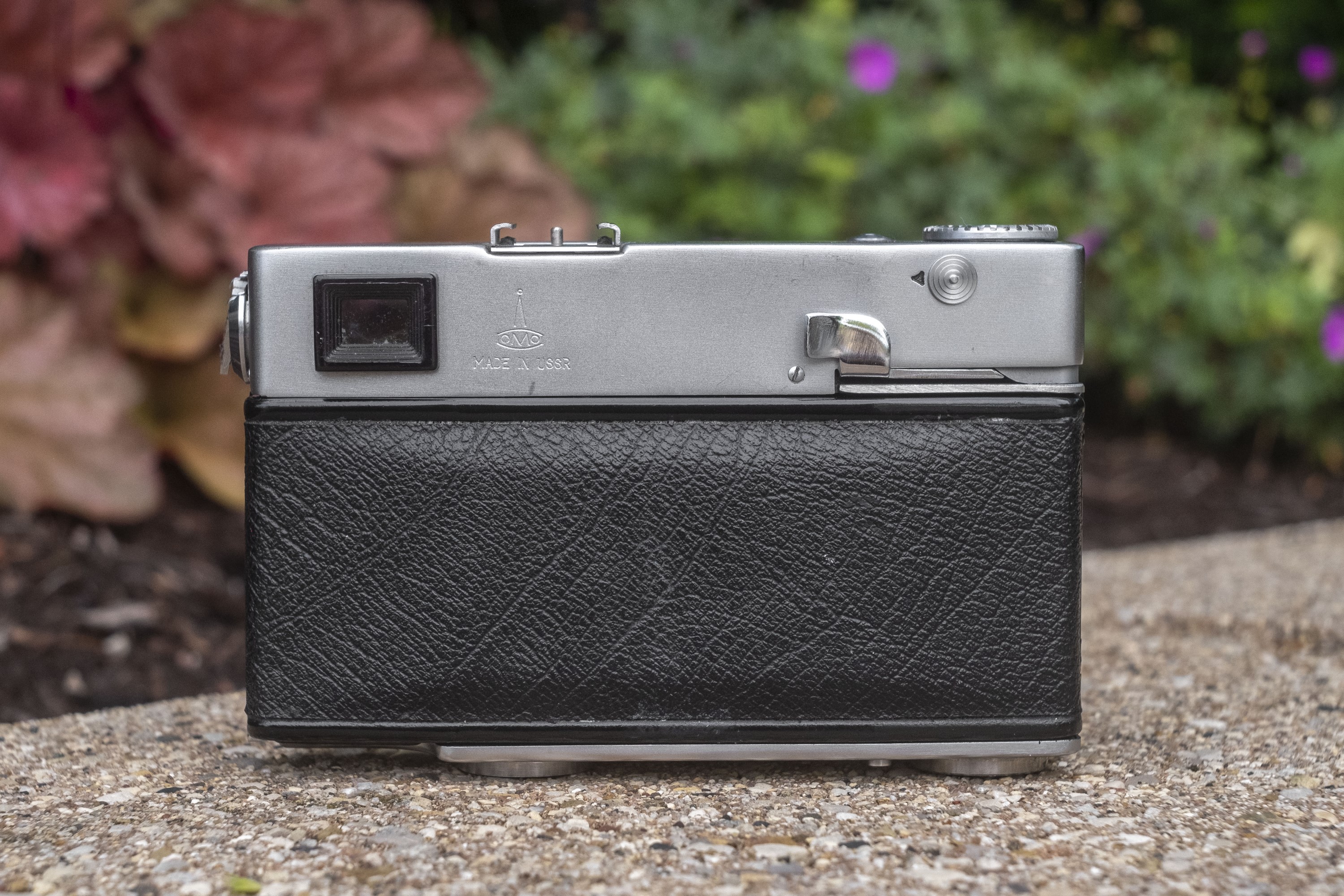
Around back is the rectangular eyepiece for the viewfinder which is next to an engraved LOMO logo and the words “Made in USSR” which, along with the Roman “Sokol Automat” logo up front, confirm this particular camera was an export model. Off to the right is the film advance lever, and above it, a battery check switch.
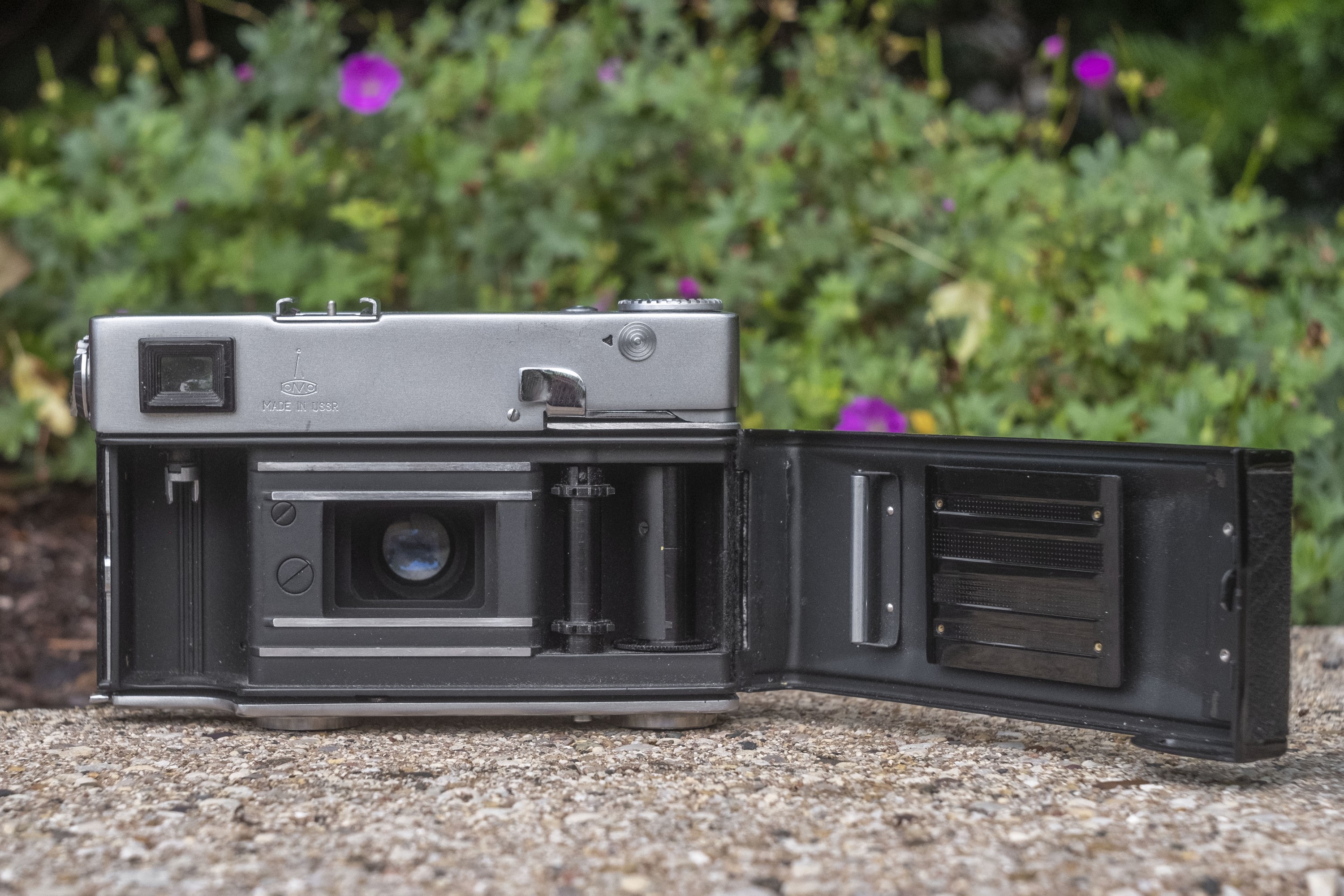
The right hinged film door opens to reveal the film compartment. Film transports from left to right onto a single slotted and fixed take up spool. Due to the design of the side mounted rewind knob, there is no way to pull up on the fork for the supply side, so a notch in the bottom of the supply side allows you to slide a new cassette in at an upward angle.
The film pressure plate is made of metal and has a curious striped and divoted pattern which I’ve never seen on another camera. There is also a metal roller next to it to help with film transport. Two large screws exist to the left of the film gate which appear to be covers for some kind of internal adjustment. I did not open them to see what was behind them. Finally, like Japanese rangefinders, the Sokol Automat uses a foam light seal on the hinge which had degraded and needed replacing.
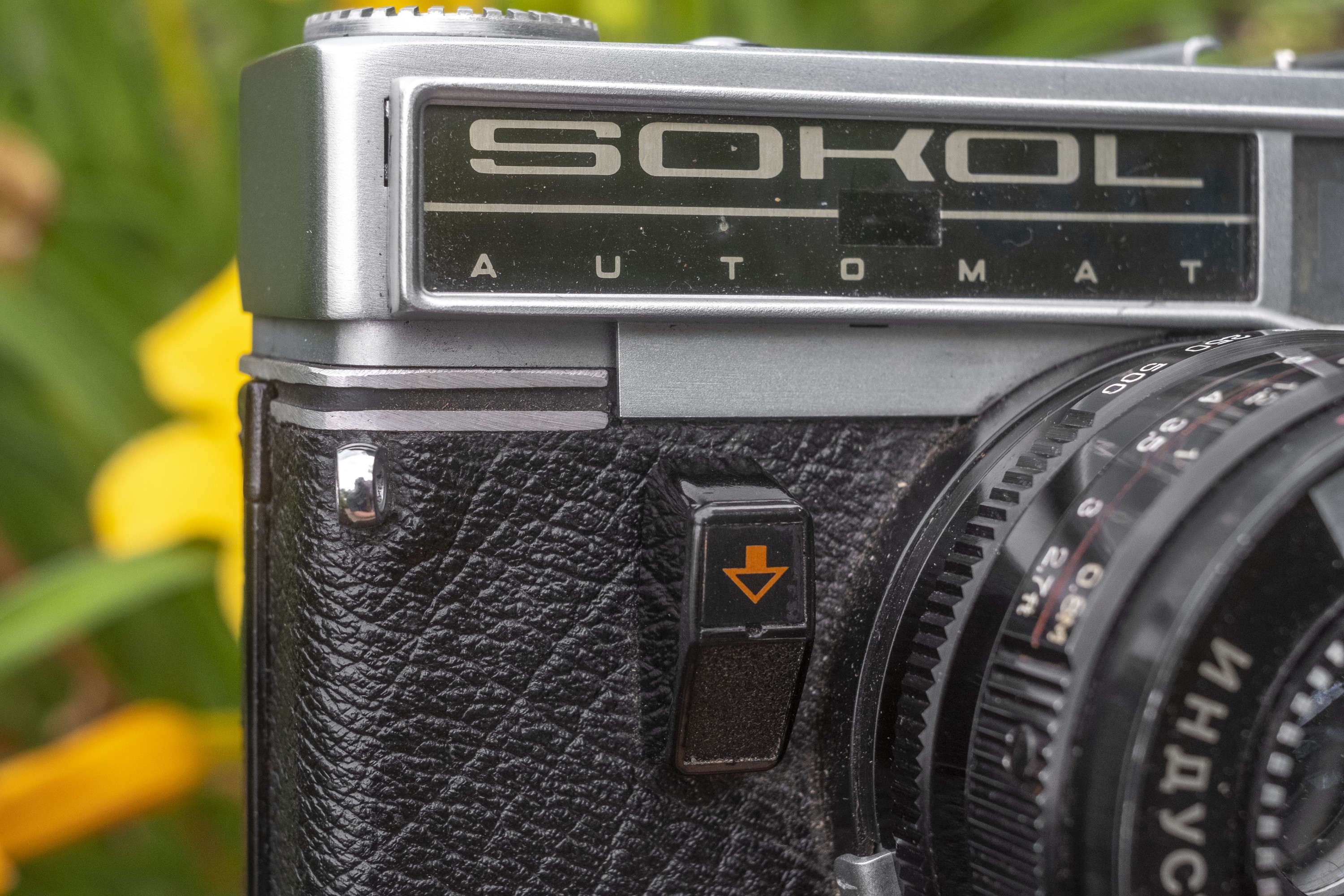
The shutter release is on the front face of the camera, in easy reach of your right index finger. Earlier versions of the Sokol Automat had a metal release, but most are plastic like the one displayed to the left. The shutter release has a rather long travel to fully actuate the shutter which is a result of how the auto exposure system works. In use, it’s not a problem, but can feel a bit awkward compared to other cameras. As mentioned earlier, a threaded cable release socket is on the top plate of the camera if you wish to use one.
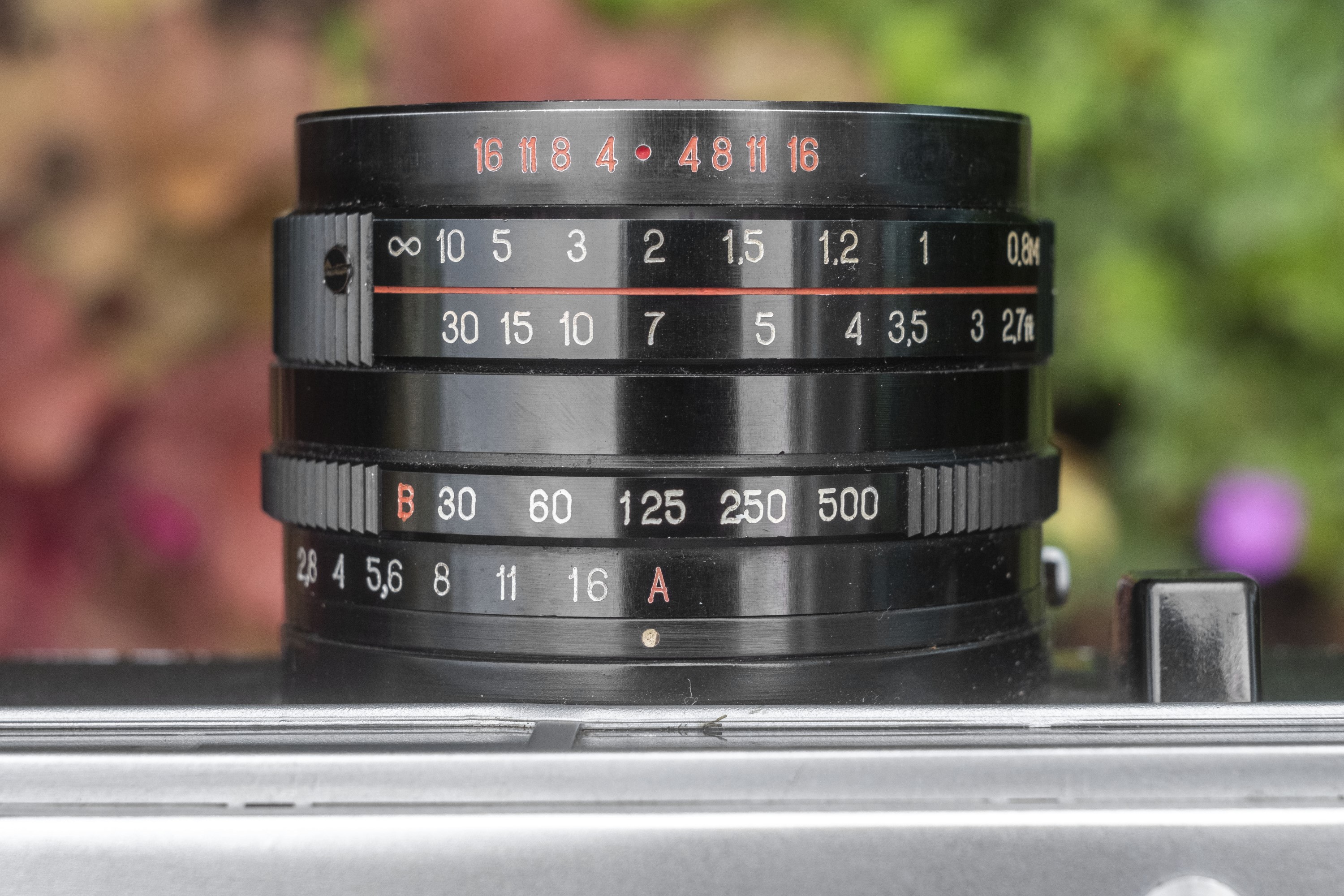
Whether or not the persistent rumor that the Sokol Automat has a shutter using technology licensed from Copal is true or not, I can tell you the shutter controls for the Sokol Automat do not function like any other Japanese camera I’ve ever used.
Cosmetically, things look innocent enough with an aperture ring closest to the body with settings from f/2.8 to f/16 and then an orange A for Auto mode. When in Auto mode, the camera uses programmed Auto Exposure, and the position of the shutter speed ring is disregarded. Above the aperture ring is a second for shutter speeds from 1/30 to 1/500 plus Bulb. When the camera is in Auto mode, the aperture ring locks into place and cannot be moved without first pressing a small metal tab on the side of the shutter near the 9 o’clock position, in the direction of the arrow. You can see this tab in the side profile image below. With the camera out of Auto mode, you have full manual control over both the shutter speed and aperture.
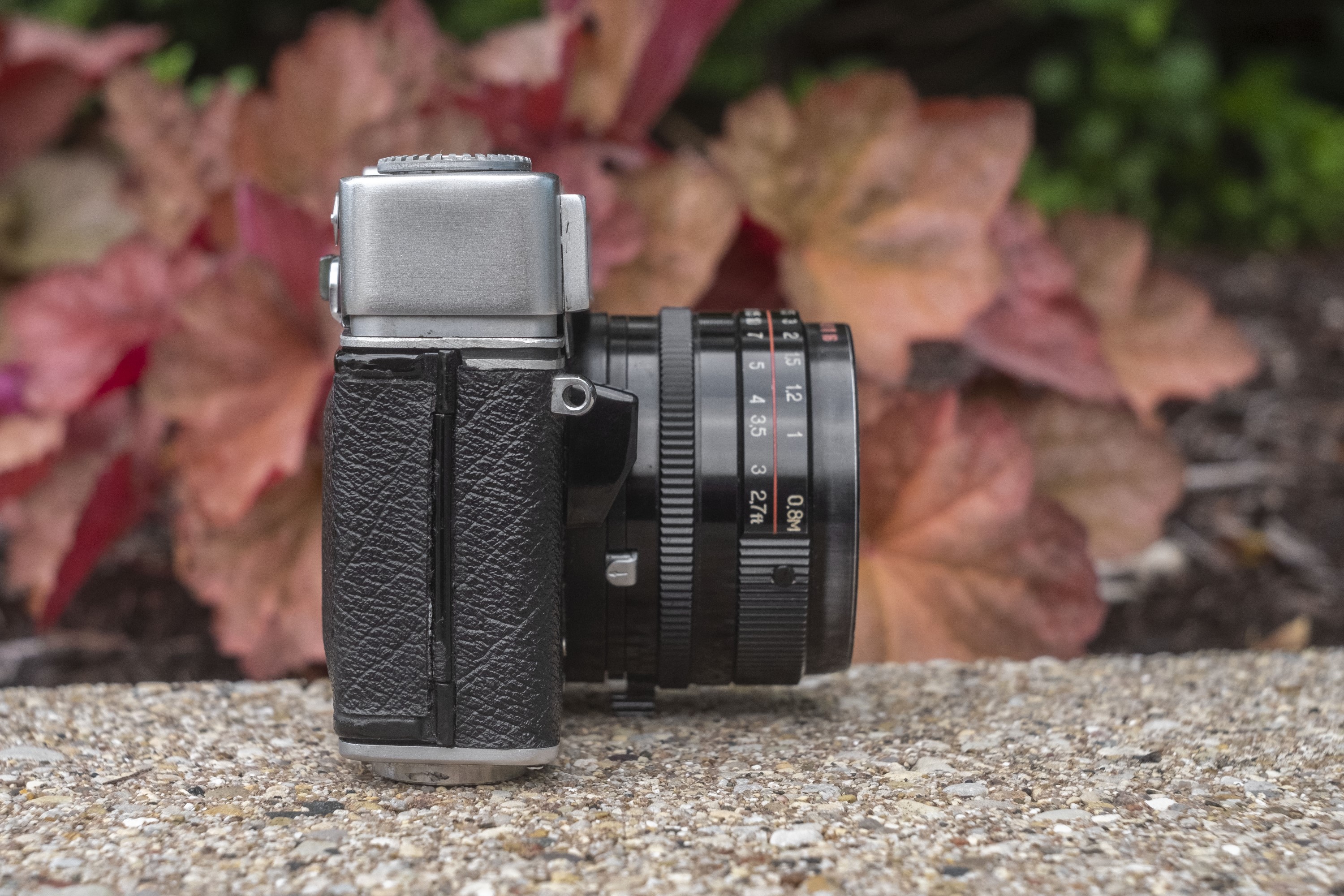
A small metal handle on the opposite side of the aperture ring makes it easier to rotate the dial, which is helpful as on my example, changing settings was very stiff. Before you can do any of this, you must first cock the shutter to make any changes to either aperture or shutter speeds. When the Sokol Automat first arrived, I had thought the camera was jammed as I couldn’t budge either the shutter speed or aperture rings, and it wasn’t until I advanced the film lever that I was able to do so. Without access to an English language manual for the Sokol or one of it’s export variants, I only stumbled upon this on accident.
The Sokol Automat’s viewfinder is one of the best found on any Soviet rangefinder and rivals that of many other fixed lens rangefinders made in other countries. Peering through it while wearing prescription glasses is not a problem as I can clearly see the projected frame lines clearly. The main part of the viewfinder has a blue tint and both the frame lines and rectangular rangefinder patch have a yellow tint which produces nice contrast, allowing you to easily focus even in dim light. The frame lines automatically correct for parallax which means as you focus the lens closer to it’s minimum, the lines shift towards the bottom right to take into account parallax error, which many lesser rangefinders do not automatically correct for. Looking through my collection of Soviet cameras, aside from the Sokol Automat, the only other rangefinder with automatic parallax correction is the Kiev 5 but if someone knows this to be different, please let me know.
Perhaps the coolest feature of the Sokol Automat’s viewfinder is how the metering system is displayed. Normally when looking through the viewfinder, on the far right is a very thin down arrow which is projected in yellow, just like the frame lines. When the arrow is displayed, this means the metering circuit is not active. To activate it, you must put pressure on the shutter release which causes the arrow to move out of the way as projected numbers start to fly across which indicate shutter speed and f/stop. With the camera in Auto mode, as you continue to put downward pressure on the shutter release the numbers will eventually stop at whatever shutter speed and f/stop the metering circuit determines will give correct exposure. In the gallery above, I show three images, the first, the meter is at 1/250 and f/2.8, the second at 1/500 and f/8, and the third shows a red rectangle, which means there is too much light to make an appropriate exposure.

Once you press the shutter release down as far as it will go, only then will the exposure be made. Half pressing the shutter release not only will not fire the shutter, but also won’t show a properly detected exposure. When the camera is not in Auto mode, the display still works, and will recommend a shutter speed and f/stop, but will fire at whatever settings you have manually selected.
Although the Sokol Automat does have some quirks that are unique to it, it is clear it’s Japanese influence extends beyond just it’s cosmetics. A bright and easy to use viewfinder with automatic parallax correction, a clever auto exposure system, and a good lens all in a large and rectangular body, it’s like a Soviet Yashica! The Sokol Automat may look Japanese however, but does it perform like one?
My Results
Not having access to an English language manual for the Sokol Automat, I was not confident in my understanding of the camera’s metering system. It seemed as though the shutter kept firing at the same speed no matter how much light or what setting it was set to. It did fire though, and I did see the exposure display in the viewfinder change, so I figured something had to be going on. For the first roll through the camera, I loaded in some heavily expired Kodak Gold 200. I figured, if those images turned out to be garbage, then I wouldn’t bother with better film.
Having seen these results showing at least some semblance of accurate metering but with some horrible light leaks, I wanted to shoot the camera again after changing the seals. I loaded in a second roll, this time of some Fuji F-64D 8522 cinema film I have in bulk supply as I know that film to be rather gritty, and I thought it would fit the Soviet camera’s “gritty” reputation.
As an aside from anything related to this camera, these are the first results from a roll where I started scanning my film using Silverfast 8 over the default Epson software. The interface in Silverfast is much more intimidating and it seems like I need to do more work to get satisfactory scans, but the difference is noticeable. Although Silverfast works with a number of scanners, if you own an Epson V550 or V600 like I do, you can get it free by registering your scanner. Even if it doesn’t become something you use often, I definitely recommend giving it a try.
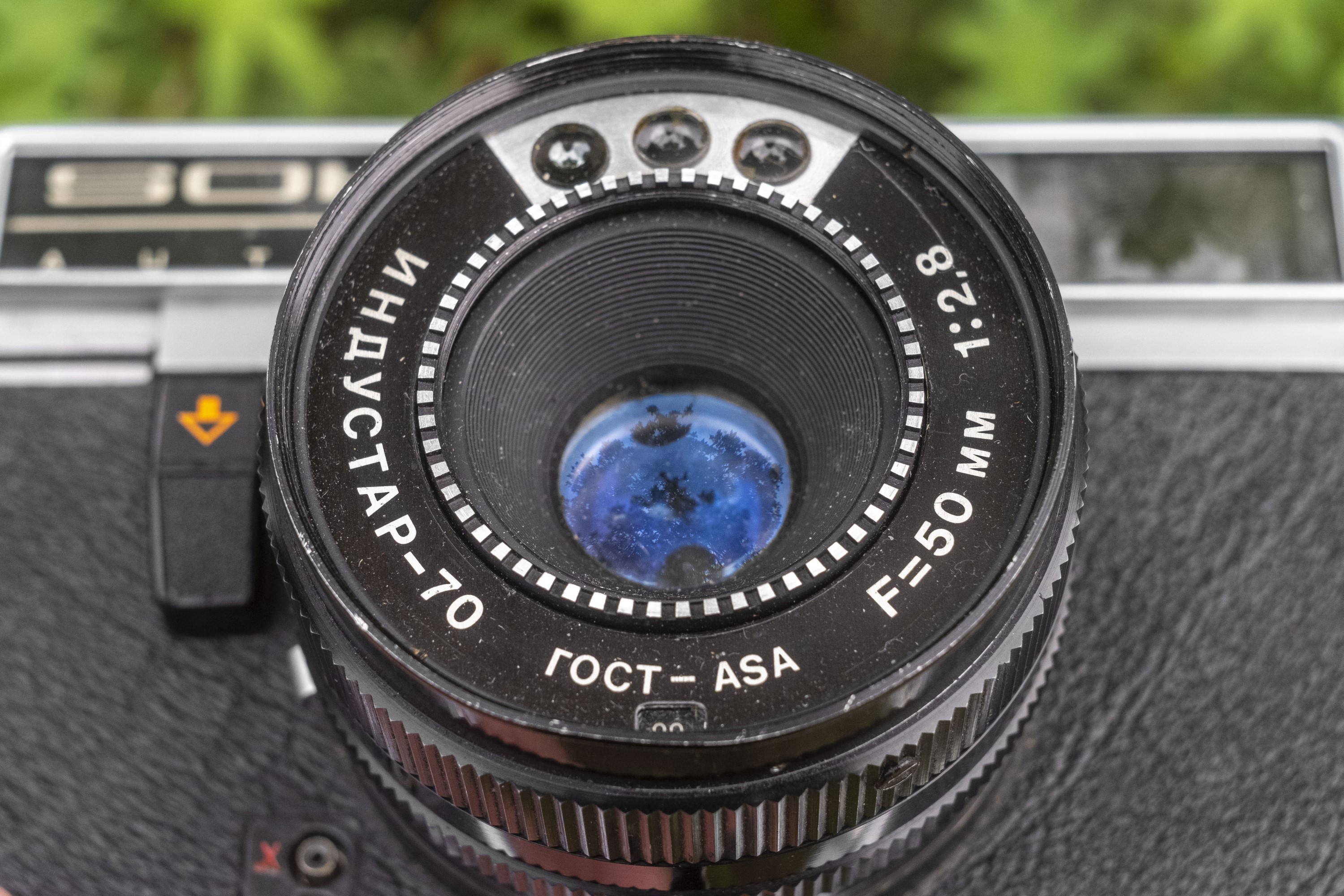
Conditional issues aside, I am very impressed with the quality of images I got from the Sokol Automat. In what probably surprises no one, the 4-element Industar-70 delivered superb images on both rolls. Sharpness was excellent across the frame with only the slightest bit of softness near the corners. While I didn’t intend on making some bokeh shots, the few times I focused close, out of focus details were pleasant. Not too smooth, but not too jarring either. There was an ever so slight amount of swirl in a couple images, giving them a look not unlike those from a Helios-44.
The metering system, while functional, has it’s limitations, which shouldn’t be surprising considering this is a half century old Soviet camera. I shot both rolls with the camera in Auto mode and the film speed set to 90 GOST as I felt it would be a safe speed that would work with both film stocks. In the case of the expired Kodak Gold, the images were under exposed, and the Fuji film just about right.

Although I didn’t need to mess with the manual exposure settings often, on several occasions where I wanted to “play” with the camera, I would briefly forget that I needed to wind the film advance to do it. I have to wonder if on other examples of the camera, an uneducated user might force something causing a mechanical failure with either the film advance or shutter.
The viewfinder is large and very bright and works well while wearing prescription glasses. Save for maybe the one on the Kiev 5 or Zorki 4, this is the best viewfinder on a Soviet rangefinder I’ve used. If your only experience with rangefinders are Japanese cameras like the Canon P or Nikon SP, you’re likely to be less impressed, but considering what they had to compete with, the designers at LOMO did an excellent job here.
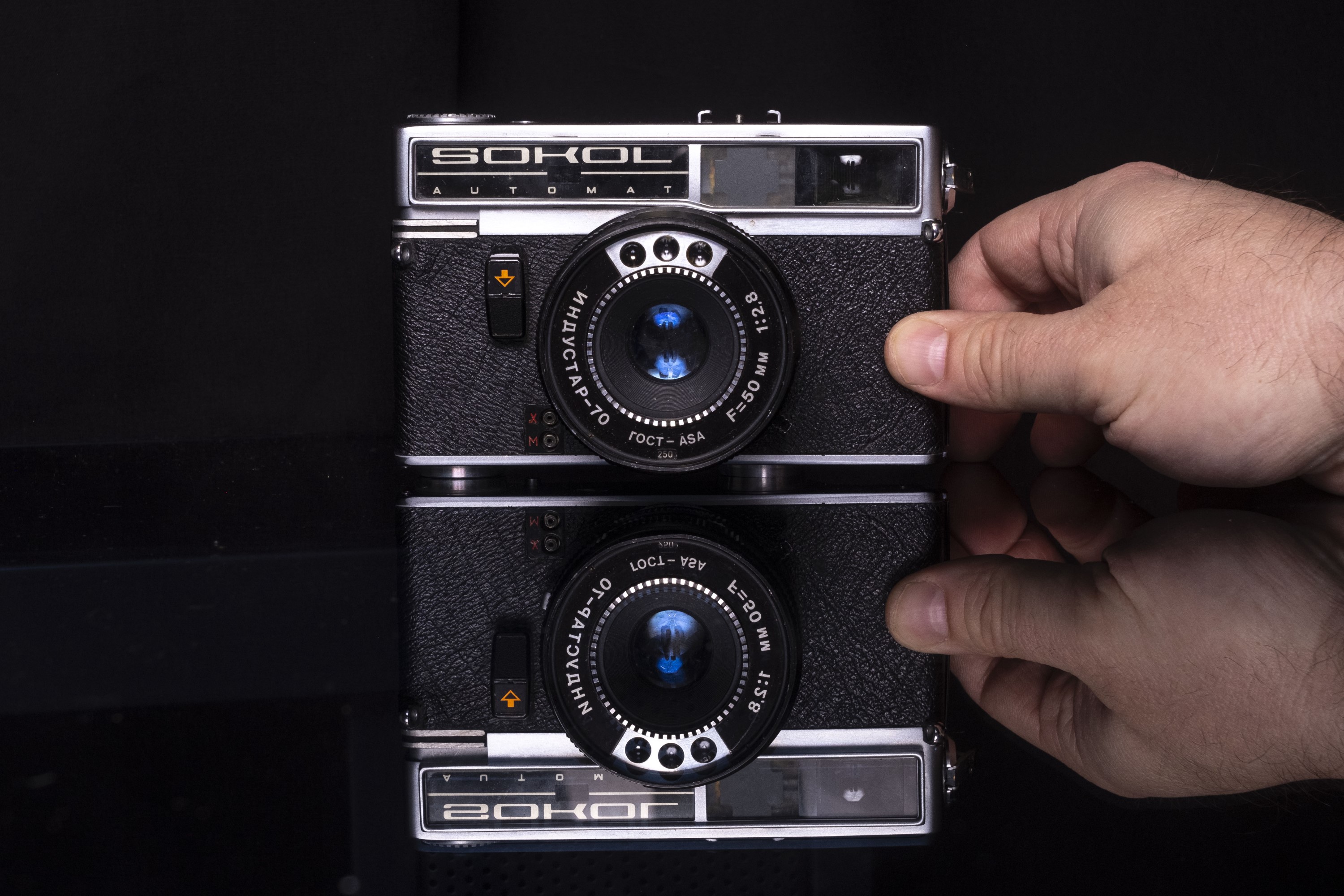
Beauty is in the eye of the beholder, and while I think there were many good looking cameras made in the Soviet Union, I find the Sokol Automat to be especially appealing. Although I’ve never seen one in person, the Aurora Automat version with the 6 meter windows takes the cake for me as one of the best looking cameras made there. Sure the camera is big and heavy, but I wouldn’t have it any other way. This is how a 1960s Russian camera should feel.
Is this the best camera ever? No. Is it the best Russian camera ever? No. Is this the best Russian rangefinder camera ever? Probably not. But what I like about the Sokol Automat is how it all works together. A lot of thought and effort clearly went into this camera to elevate it to “not just another Russian rangefinder”. Although mine is in rough shape and likely hasn’t been serviced in several decades, I got some really good images from it. I am confident that when found in perfectly working shape, the Sokol Automat is as good as anything else out there and is definitely worthy of adding to any collection.
Related Posts You Might Enjoy
External Links
https://camerapedia.fandom.com/wiki/Sokol_Automat
http://sovietcams.com/indexd988.html
http://cameras.alfredklomp.com/sokol2/
https://w.atwiki.jp/saltysugar/pages/41.html
https://tomtiger.home.xs4all.nl/sokol2.html
http://photohistory.ru/index.php?pid=1207248178819228 (in Russian)
http://rangefinder.ru/oboz/showproduct.php/product/87/cat/5 (in Russian)
https://eastrise.wordpress.com/2017/05/12/семейство-фотоаппаратов-сокол/ (in Russian)

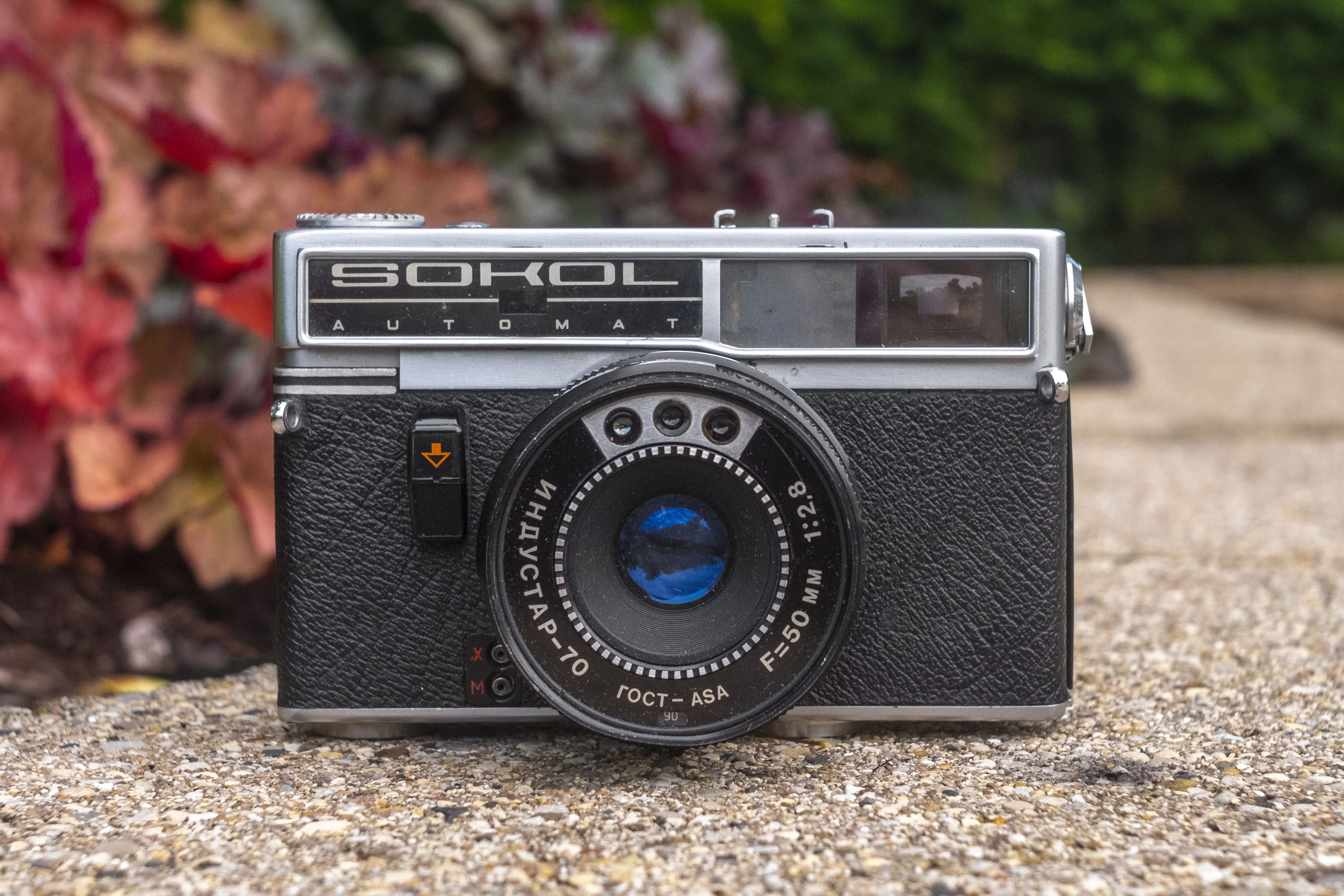
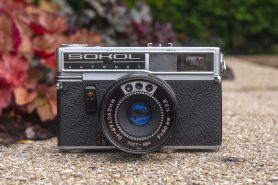
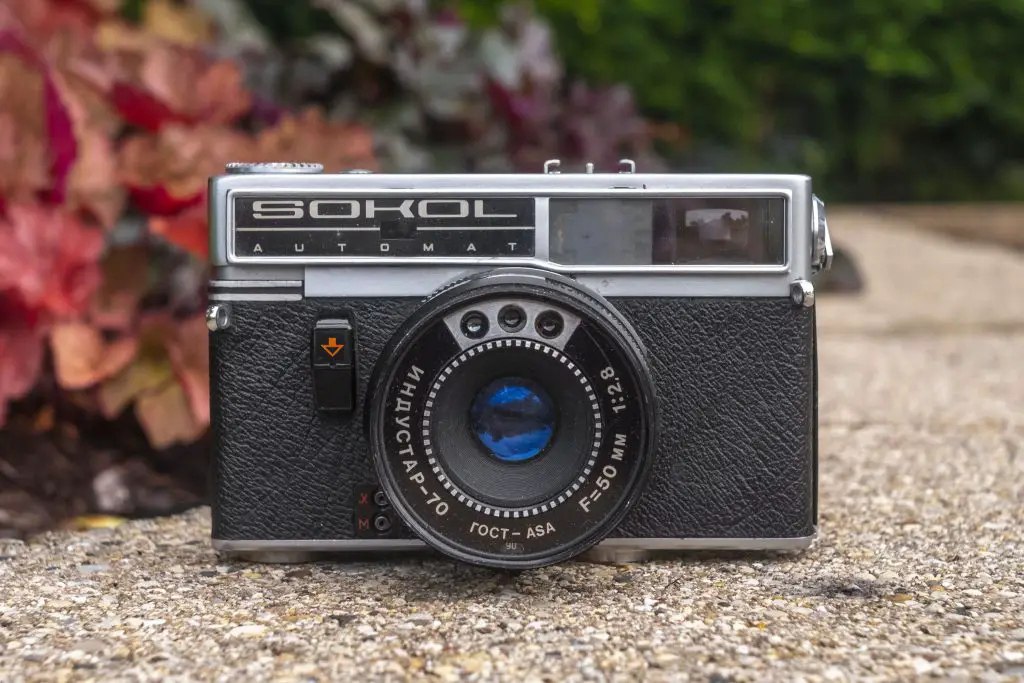
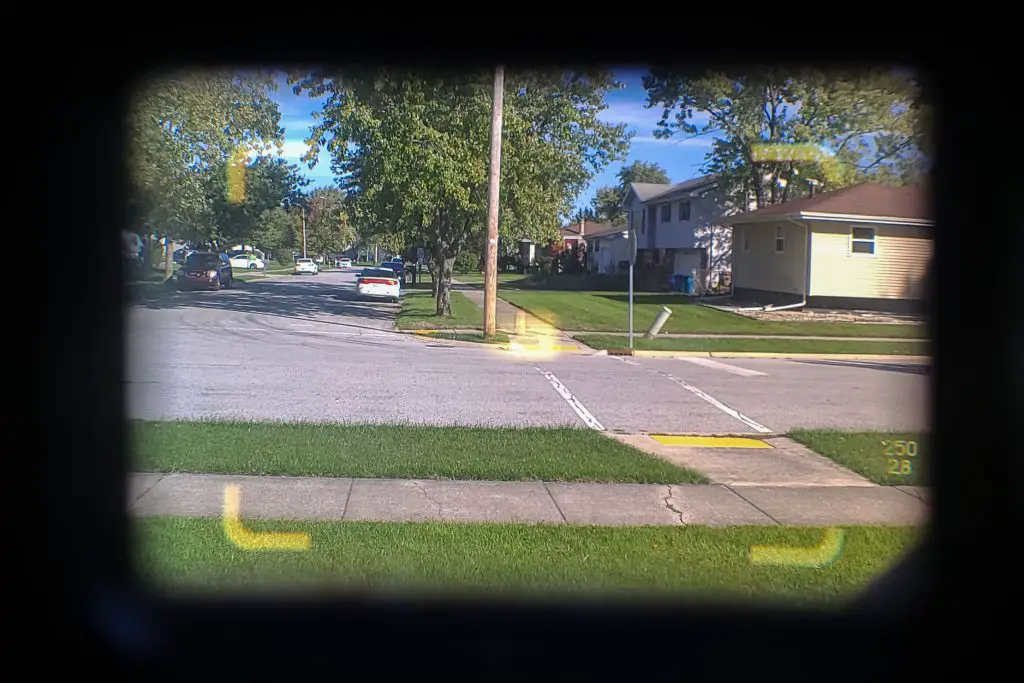
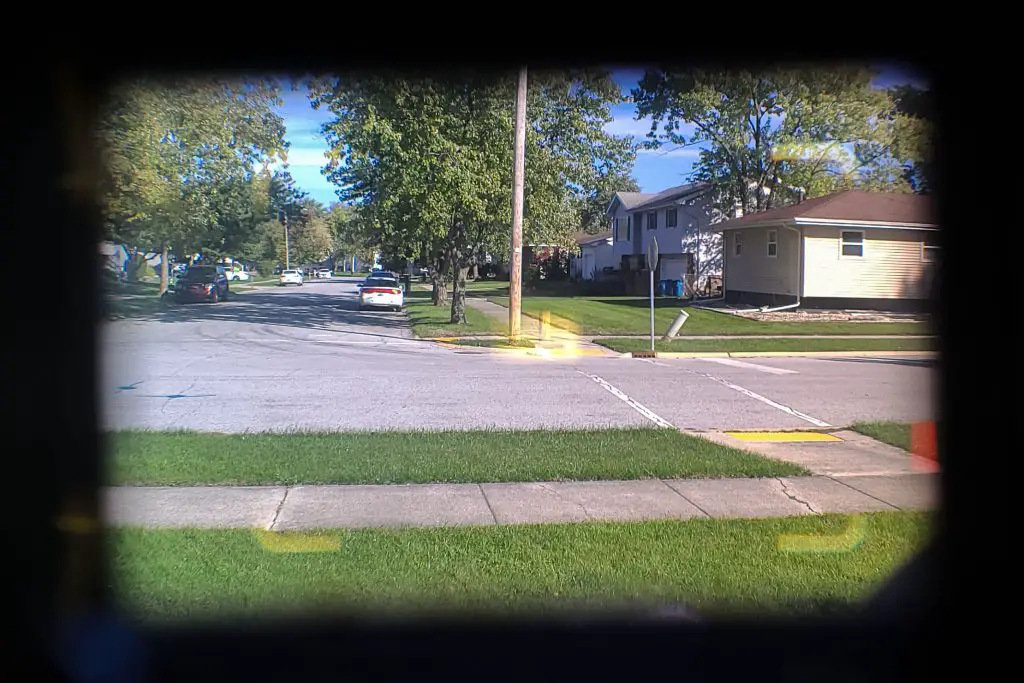
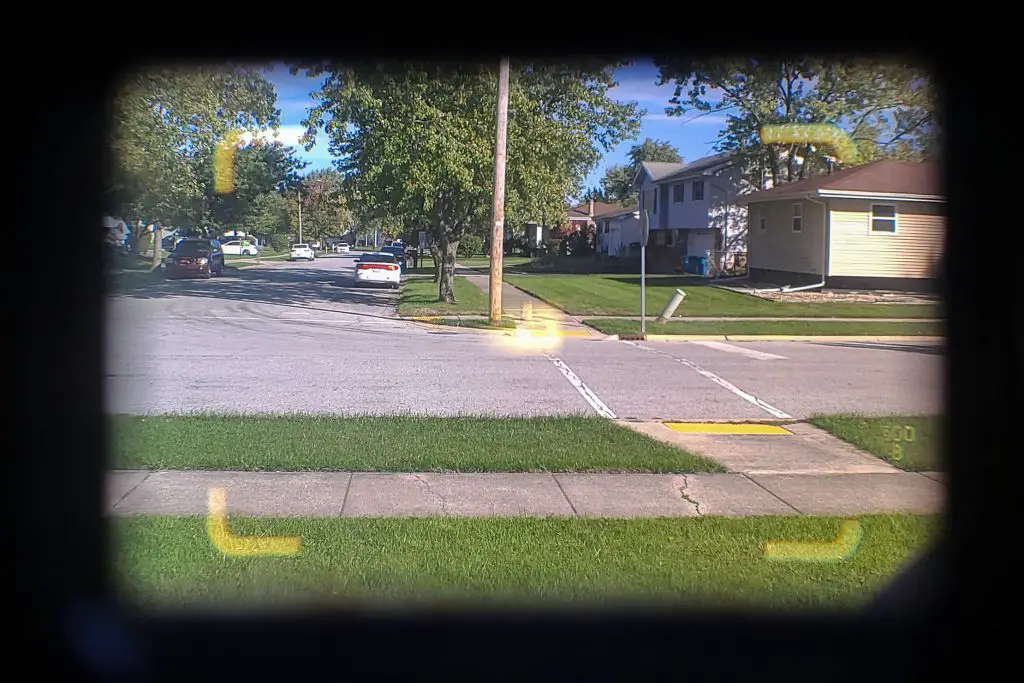





















Mike, what an interesting camera, and un-Russian like in design. You’ve got me spending my money again, , as one is wending its way from Russia as I type! The model is identical to the one you review here.
Do you have any info why it was necessary to initially have six Cds meter cells and then reduced to 3, especially as Japanese cameras of the time have only ever had one? Were Soviet cells of the era so unresponsive to light that they needed them in series connection to fully cover the EV range of the camera?
The lens does look up to performing at the top end of the f2.8 Industar designs, as your latest scanning technique with Silverfast clearly demonstrates. I think you’ve upped the ante here, with your large image files. Keep up the good work!
Mike Eckman strikes again! Hopefully you enjoy yours as much as I did mine. Let me know how it turns out when you get it.
The Sokol is more accurately a shutter-priority autoexposure with automatic override; like the Fujica Auto-M, the camera will adjust the shutter speed up or down if the user-selected speed is inadequate for the given lighting conditions (Fujica referred to this as a “programming” shutter). The Sokol improved on the design by displaying the aperture and shutter speed in the viewfinder, whereas the Fujica did not display any exposure information. Pretty clever.